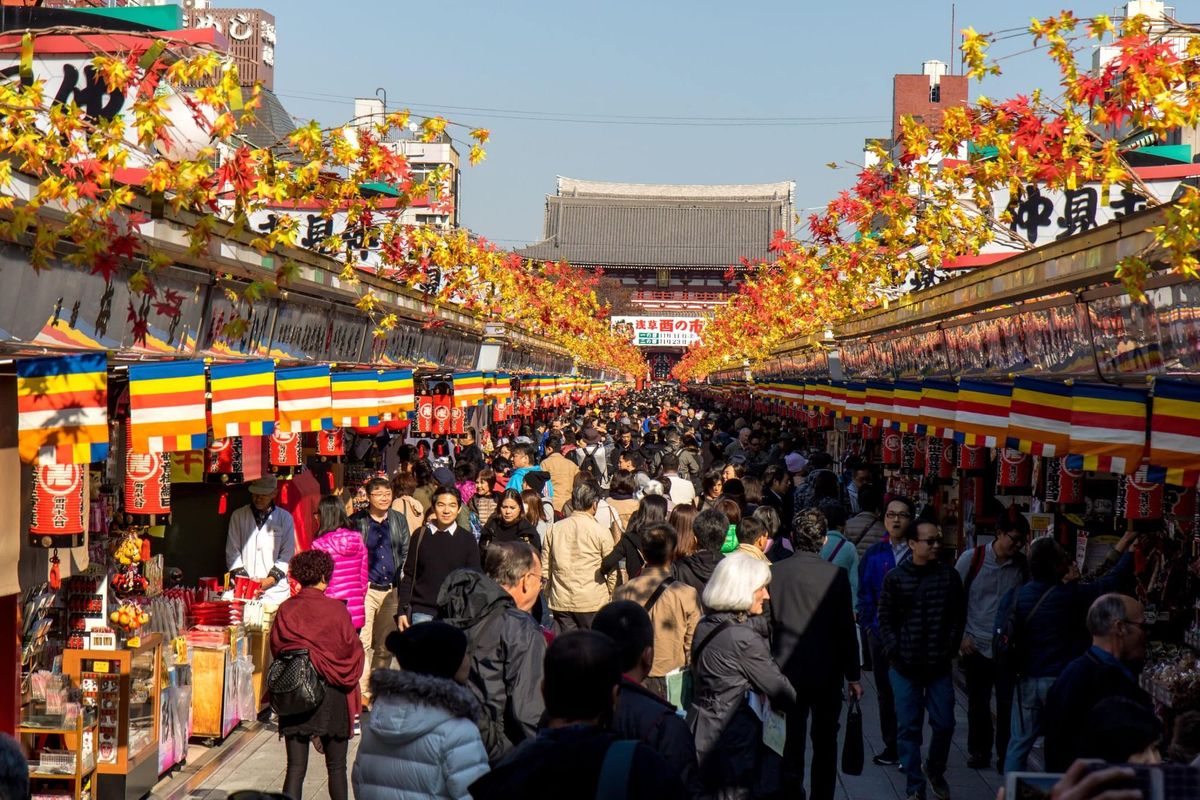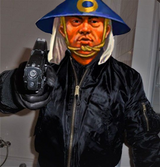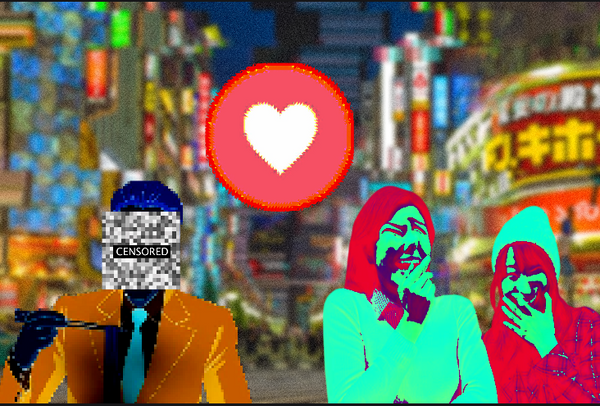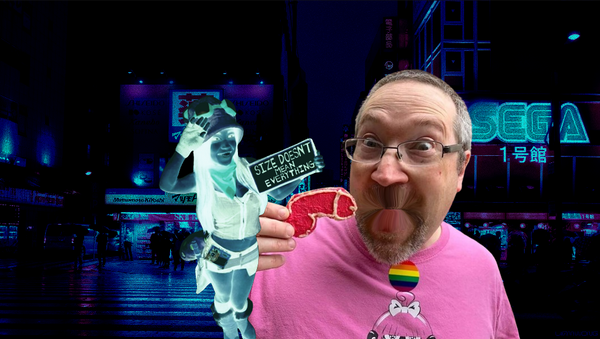What To Buy At Nakamise Shopping Street

You don’t have to buy everything on our list at Nakamise Shopping Street, but you might just end up wanting to anyway. Just be sure not to spoil your appetite for dinner.
Filled with traditional street food and a wide variety of souvenirs, Nakamise Dori is a must-visit for anyone in Asakusa. Since this shopping street features almost 100 stores and is usually packed with people, it’s good to have a general idea of what’s there before you go.
That way you don’t miss any of the best souvenirs and food. From katana samurai swords to animal-shaped candy, there’s something for everyone on Nakamise Dori.

Nakamise Dori Overview
Nakamise Dori is a 250-meter pedestrian shopping street located in the Asakusa district of Taito, Tokyo, Japan. It leads into the Senso-ji temple complex, one of the largest and most famous in all of Japan. Because the temple and surrounding grounds are all so popular, a large crowd forms in a kind of line to enter. Nakamise Dori is filled with shops that serve these crowds while they wait to enter the temple grounds.
A lot of these shops sell food. Whether you’re going to Senso-ji during the cold Japanese winter and need something to warm you up, or you’re there during the hot Tokyo summer and need something refreshing, Nakamise Dori keeps you comfortable.
It’s more than food, though. Nakamise Dori features some 89 shops, many dedicated to traditional Japanese crafts like woodblock printing and chopstick making. Not only are these shops fun to look through and browse while you make your way to Senso-ji, but they sell these items as high-quality souvenirs that let you remember your time in Japan with a sophisticated touch.

The History of Nakamise Dori
Despite being an icon of Tokyo and mainstay of Asakusa tourism, Nakamise Dori has actually had a very tumultuous history. Though the Senso-ji temple was built as long ago as 941 AD, in 1649, the Tokugawa shogunate enlarged it and rebuilt many of the structures. Plus, Tokyo, the shogunate’s capital, became an increasingly important economic and cultural center of Japan.
As a result, by the early 18th Century, many pilgrims were coming to Senso-ji. The shogunate authorized shopkeepers to put shops on the street leading up to it, and thus Nakamise Dori began.
Unfortunately, after the Tokugawa shogunate was overthrown in the Meiji Restoration, the government of Tokyo ordered the shopkeepers to leave. Then, they reconstructed the entire area in brick after the Western-style, which was destroyed in the Great Kanto Earthquake of 1923.
The street was rebuilt again in 1925 using concrete, but allied bombings in World War II destroyed all that again. It was finally rebuilt in its current form after the war.

How to Get to Nakamise Dori
One nice thing about Nakamise Dori is that it’s incredibly easy to get to. It’s just two minutes and about three blocks from Asakusa Station. This is a station accessible by the various private metro lines in Tokyo: Tobu Railway, Tokyo Metro and Toei Subway. It’s a major stop on the Ginza line.
If you have the JR Pass, these private metro lines are unfortunately not covered. However, to get as close as possible, you can take the JR Yamanote line to Ueno Station. From there you can connect to the Ginza line, and it’s just an eight-minute ride to Asakusa Station. If you’re in good shape and don’t feel like paying for the private metro, it’s a little over a mile walk, around 25 minutes.
These are the easiest ways, but you can also get creative. Specifically, you can get around Asakusa in go-karts or rickshaws. Go-kart tours are very popular in the area. A guide will take you around in a group of go-karts, showing you all the sights in style. Rickshaws depart from Asakusa Station and will take you anywhere you want to go in traditional Edo fashion.
The 15 Best Souvenirs and Food to Buy at Nakamise Dori

1. Candy and Sweets
Candies make for tasty treats while browsing the shopping street, and they can also be souvenirs. There are a number of options on Nakamise Dori, too, ranging from strange, exotic traditional Japanese candies to standard sweets even your little kids will appreciate.
A traditional Japanese candy that makes for a great edible souvenir is Amezaiku. This is a traditional Japanese culinary artform that results in intricate candy sculptures that look as if they were blown from glass.
The candies often look like animals and are painted with edible dyes to look even more stunning. You’ll probably feel guilty eating the amazing work of art, but don’t worry. Amezaiuku practitioners can make hundreds a day!
Yokan is another traditional sweet you can buy readily on Nakamise Dori. It’s a jelly ball—or cube—made from red bean paste. This paste is the traditional sweetener in Japan and considerably milder than Western sweeteners like sugar and high fructose corn syrup.
You can find many varieties on Nakamise Dori, including imo yokan made from sweet potatoes, shio yokan with salt and mizu yokan which is made with extra water and chilled in the summer. If your kids balk at the lack of sweetness, you can get modern versions with sugar and honey too.
Besides these, there are plenty more candies to find as well. Many come in colorful designs and pretty boxes that can help you remember your trip, even after you eat the candy.

2. Rice Crackers
Rice crackers are a go-to snack for the Japanese people, so you might as well get some for yourself while you’re shopping on Nakamise Dori. The most common variation you’ll find is senbei. These are charcoal baked rice crackers, sometimes flavored with soy sauce. They serve the same culinary purpose as wheat crackers in the West. They’re a snack or appetizer people often eat at tea time.
Senbei keep well, so you can easily take them home. They also just make a great snack during your trip. You can keep yourself or your kids fed while still enjoying the local culture.
Kaminari Okoshi is another rice cracker snack you can buy on Nakamise Dori. These are puff rice crackers that are mildly sweetened. You might even think of them like Japanese rice crispies treats. They may include other ingredients like peanuts or flavoring.
Kaminari Okoshi are especially associated with the Senso-ji temple, which is how they got their name. Kaminari means “thunder,” which you may recognize from Senso-ji’s Kaminarimon, or “thunder gate,” which leads into Nakamise Dori.

3. Kimonos
What would be a better way to remember your time in Japan than a beautiful, traditional kimono. Naturally, kimonos are a popular souvenir for tourists in Japan, and many shops along Nakamise Dori cater to this.
As with anything, especially clothing, kimono prices and quality can vary greatly. For the most expensive, hand-woven kimonos, you’ll have to go to a specialty shop or a second-hand kimono store. Plenty of stalls along Nakamise Dori offer high-quality mid-range products, though, that are comfortable and feature the traditional patterns that kimono are known for. Depending on your budget and purposes, you can choose from both real silk and polyester.

4. Zori
If you’re going to get a kimono, you’ve got to spring for some zori too. These Japanese thonged sandals are the perfect souvenir because not only do they remind you of your experience walking around Nakamise Dori and Asakusa, but they’re comfortable too. That’s probably why they were actually one of the first “souvenirs” people began taking away from Japan. American servicemen loved them and took a lot back home with them after World War II.

5. Tabi Socks
Tabi socks are socks designed for zori. That means they have a big toe separate from the rest of the sock. Of course, that means if you buy any zori, you’ll need tabi socks to go with them. Regular socks won’t work, or they will be uncomfortable at least.
However, practicality isn’t the main reason to buy tabi socks on Nakamise Dori. In fact, you don’t even need to have zori at all. It’s the many elaborate and colorful designs that’ll convince you. These could be scenes from traditional Japanese art or characters from Japanese otaku culture as well as many more.
Regardless of the design you get, tabi socks are a comfortable addition to your wardrobe. I know I personally love the soft feeling of the cloth between my toes. You’ll enjoy wearing them with any kind of shoes, not just zori.

6. Ice Cream
Now, you might not think of ice cream as a very typical Japanese street food, but hear me out. First of all, I don’t think I’ve ever seen any ice cream places with as large a variety, or at least as strange of one, as in Japan. That means your classics like vanilla and chocolate, some rarer kinds like blueberry and purple sweet potato, but also some just straight weird ones like soy sauce and seaweed.
Of course, what you should really try is the matcha flavor. Almost everything in Japan comes in a matcha version, but matcha ice cream is by far one of the best. If you don’t already know, matcha is a powder made from green tea that can be added to anything.
If you’re visiting Asakusa in the summer, ice cream is a good option for a snack on your way down Nakamise Dori street. The Tokyo sun can be hot, especially in the crowded market, so cool yourself off.

7. Ningyo Yaki
When you go to Nakamise Dori, you’re bound to find numerous shops selling what look like little wood carvings… but smell like cake? These are ningyo yaki! They’re cakes filled with the Japanese traditional sweetener, red bean paste.
While these treats taste great, the coolest thing about them is their incredibly intricate designs. Most are often shaped as animals or traditional Japanese figures with a detail that you’d think impossible for baked goods.
As an added bonus, you can actually watch these cakes be made. The shops use the traditional method that bakers have used for almost a century. Grab a bag to take home with you, but at least try a few before you leave Nakamise Dori.

8. Chopsticks
Chopsticks and Japanese cuisine go hand in hand. Maybe you went to Japan specifically because you love the food, or maybe you went for other reasons and have come to love it. Either way, chances are you’re going to want to bring the nation’s culinary mastery home with you. That means your own pair of chopsticks.
While you’re probably used to the disposable wooden chopsticks at Western restaurants or at best the plain washable plastic ones, Japan takes it to another level. The name for a chopstick maker is morita, and he takes his craft very seriously.
A personal chopstick set is a beautiful souvenir and one of the things most reminiscent of Japan that you’ll find on Nakamise Dori. Many morita will even write your name on the chopsticks for a small fee.

9. Fans
Fans aren’t just beautiful decorations but practical items you can use in Japan and back home to fight the summer heat. For this reason, they are a stylish yet inexpensive souvenir you can pick up all over Nakamise Dori. In fact, you can find plenty for under ¥2,000 (about $20).
Fans, or sensu, are a traditional artform in Japan. These foldable fans were actually invented in Japan and are very representative of the country’s culture. To further this, you can find many with famous Japanese paintings or designs on them.
My advice? Get a couple. Go for a high-quality, expensive fan with a beautiful design to take home with you. For walking around Asakusa in the summer heat, buy a cheap one.

10. Woodblock Prints
Woodblock printing is an ancient East Asian artform that involves printing text or pictures on a block of wood which can then be used to transfer the designs to cloth or paper. The elaborate artform developed in Japan into what is known as ukiyo-e. You may be familiar with the piece Under the Wave off Kanagawa by Hokusai, which features a large wave crashing down on a boat. This is one of these ukiyo-e woodblock prints.
Nakamise Dori has many establishments offering affordable woodblock prints, including Sakai Kokodo, one of the oldest stores specializing in this artform. It was opened in 1870. You can buy a woodblock print that will match nicely with the rest of the art and decorations in your home, especially if you already have an Eastern motif going on.
As a bonus, for those who really like woodblock prints, you can buy the supplies to do it yourself at a few shops along Nakamise Dori. If you don’t know how, don’t worry. A woodblock printing class is one of the best things to do in Asakusa and easy to find.

11. Dango Dumplings
Dango was actually my first taste of Japanese street food. I have to say, as a first go, they were great, because despite being mild, they still introduced me to the different flavors and textures traditional in Japanese cuisine.
Specifically, dango are sweet—mildly sweet, not candy—dumplings made from rice flour. There are many different kinds, but the type I’ve seen most frequently on Nakamise Dori is mitarashi. These are covered in a syrup made from soy sauce, starch and sugar. They’re shaped into balls and served four or five at a time on skewers.

12. Katana
Fulfill your dreams—or your kids’—of being a samurai with a real katana—or a fake one. Now, a real katana is an expensive souvenir, but it’s an impressive one too. These incredible, sophisticated weapons served the Japanese samurai for centuries, and a legitimate replica that is made to the same quality and can be sharpened can only be found in Japan.
Of course, if you don’t want to spend over ¥100,000, or if you don’t want your kid slicing off his arm on accident, you can get replicas made from zinc-aluminum alloy that can’t be sharpened. These are much cheaper but still make great decorations, often including hand-crafted sheaths with beautiful designs.
Besides katana, you can find other ancient weapons and martial souvenirs along Nakamise Dori as well. These include Japanese knives, famous since ancient times for their durability and metalworking.

13. Lanterns
One of the first things that will impress you when you step onto Nakamise Dori are the hundreds, maybe even thousands, of beautiful, differently painted Japanese lanterns. At night, these are especially impressive.
The shops selling lanterns are numerous, and the products are inexpensive. More importantly, they’re very convenient for travelers. You can easily break down the lantern and fold it to store it away in your luggage. If that’s still too much, these shops normally offer mini lanterns as well, some as small as keychains.

14. Horifuda
Horifuda are essentially the Japanese versions of keychains, so you can understand why they’re great souvenirs. These wooden charms feature engravings of just about anything you can imagine. Many shops have a large selection of pre-made horifuda with English and Japanese names as well as sayings and wishes.
However, what you should really do is get one custom made. This can cost a little more, but not much, and you can get almost anything you want translated into Japanese. Names make great gifts, or if you want something for yourself, you can go with Shinto prayers or wishes for family members and friends. Couples can get both their names engraved as a perfect memory.

15. Furoshiki
Finally, you should consider getting a furoshiki cloth. Traditionally, these were used to bundle clothes at the public baths. However, their use eventually became much more varied, including even featuring maps for soldiers in World War II.
Now, along with many other things, they serve as wrapping paper. Whatever gifts or souvenirs you buy on Nakamise Dori, you can buy a furoshiki to wrap them. Not only are they a beautiful way to present a gift, they’re a gift all their own since they can either be reused for wrapping or used as a bathing cloth.
A number of shops along Nakamise Dori sell furoshiki. Some may even offer to help you wrap items with them.
4 Things To Do After Nakamise Dori
Asakusa is one of the most popular and sight-filled districts in Tokyo. Don’t limit yourself to Nakamise Dori, which, although full of shops, shouldn’t take you too long to complete. Once you come out the other end, there’s so much more to see and do.

1. Senso-ji Temple
If you’re visiting Nakamise Dori, you probably already know about and have plans to visit Senso-ji, the ancient Buddhist temple located in Asakusa. With over 30 million yearly visitors, it’s the most visited spiritual site in the world.
Well, it’ll be pretty hard to miss Senso-ji because Nakamise Dori spits you right out at the Hozomon Gate, and you have to pass the Kaminarimon gate just to enter. Be sure you take it all in. That means checking out more than the main hall, but also the five-story pagoda, the Denboin garden and the smaller Asakusa Shinto shrine.

2. Hoppy Street
Doing Nakamise Dori and Senso-ji in the evening is always a good choice. As the sun sets, the lights of the temple grounds become incredible. Plus, when you’re finished there you can head for dinner and drinks.
Just a few minutes west of Nakamise Dori, Hoppy Street is an area for nightlife in Asakusa. You can eat traditional Japanese dishes and drink sake all at great prices. As an added bonus, you can enjoy the beautiful Japanese lantern decorations.

3. Take a class
No doubt you saw some things on Nakamise Dori that you hadn’t heard of before. You may have learned something new or discovered a new artform you’d like to explore. Most likely, whatever it was, there’s probably a class for it in Asakusa. From woodblock printing to cooking ramen, there are academies and private teachers galore, many just blocks away from the Senso-ji temple complex.
If you don’t already have a class reserved, don’t worry. Just whip out your phone and Google nearby teachers. There will probably be some that still have slots open before you leave Japan.

4. More souvenirs?
If for some bizarre reason you didn’t find what you were looking for on Nakamise Dori, there are plenty more places to find souvenirs in Asakusa. One popular place is the Nishi Sando promenade just left of the temple and technically owned by it.
It’s about 100 meters long, indoors, and a good go-to for Sensoji memorabilia. Many department stores in the area also sell souvenirs along with other items including the Asakusa Don Quijote and Kappabashi Kitchen Town.

Embrace the crowd
As a last word of advice, just know that when you go to Nakamise Dori, it’s going to be crowded. This shouldn’t keep you from going. Far from it, the crowd is part of the experience and its excitement.
As you wait to press through the endless congregation of people outside Senso-ji temple, take plenty of time to look around you. Soak in the views of the magnificent temple grounds, the colorful shops and, of course, the throngs of people who have come from all over the world to see this cultural icon.





